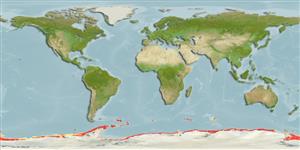|
Leptothecata |
Sertulariidae
Environment: milieu / climate zone / depth range / distribution range
Ecologia
; distribuzione batimetrica 55 - 870 m (Ref. 7414). Polar
Antarctic: Antarctica, South Georgia and South Orkney Island.
Length at first maturity / Size / Peso / Age
Maturity: Lm ? range ? - ? cm Max length : 6.0 cm COLD maschio/sesso non determinato; (Ref. 7414)
Colonies composed of masses of interwoven, usually polysiphonic stems and branches with anastomoses, up to 60mm in diameter. Hydrothecae present along whole length of colony, arranged in decussate pairs forming four longitudinal rows. Hydrothecae immersed
into branches for approximately one-third of volume. Free adcauline wall of hydrotheca one-sixth to one-tenth of its total length, straight. Abcauline wall slightly convex basally, but becoming concave distally. Hydrothecal aperture circular; rim even and usually with numerous renovations. Male and female gonothecae present. Female gonothecae typically set in a glomulus formed by a series of stolonal tubes from which the individual gonothecae
arise. Stolons also provided with isolated hydrothecae arranged in an irregular pattern; hydrothecae of glomulus smaller and with a larger part of the adcauline wall free. Gonotheca urn-shaped, with a globular basal part narrowing into a large distal neck provided with a wide distal aperture. Gonothecal wall with striae at base of neck. Female gonothecae also inserting individually at hydrothecal base. Male gonothecae not aggregated in a glomulus but arising directly at hydrothecal base. Male gonotheca fusiform, provided with a small and circular aperture at the end of a short conical neck.
Species had been collected from depths 200 to 672 m on muddy bottoms and 55 to 870 m, growing on gravel. It is used by a substratum by species of Hebella sp (Ref. 7414).
Life cycle and mating behavior
Maturità | Riproduzione | Deposizione | Uova | Fecundity | Larve
Members of the order Leptothecata include L-form hydroids. Life cycle: The zygote develops into planula and later into polyp then into free-swimming medusa.
Peña Cantero, A.L. and W. Vervoort. 2003. (Ref. 7414)
IUCN Red List Status (Ref. 130435)
CITES status (Ref. 108899)
Not Evaluated
Not Evaluated
Threat to humans
Harmless
Human uses
| FishSource |
Strumenti
Informazioni ulteriori
Age/SizeAccrescimentoLength-weightLength-lengthMorfologiaLarveAbbondanza
Fonti Internet
Estimates based on models
Preferred temperature
(Ref.
115969): -1.8 - 1.3, mean -0.7 (based on 532 cells).
Vulnerability
Low vulnerability (10 of 100).
